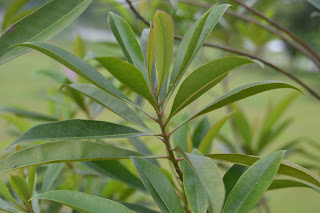Citharexylum spinosum, also known as Fiddlewood, is native to the West Indies and is from the family Verbenaceae.
This small evergreen tree can grow up to a height of 12m.
Its leaves are up to 20cm by 10cm and are attached to petioles that are green
but it turns orange when aged and eventually drops off. The petioles are 5–30mm
long. Leaf surface is generally papery or almost leathery in texture. It is
about 4–20cm long and 1–6cm wide, smooth on the upper side, smooth or a little
hairy on the underside. Colour is dark green on both sides or slightly brighter
or rusty on the underside with the leaf margin being smooth. The fiddlewood is often grown for aesthetic purposes due to orangey appearance when leaves age.
Flowers are
unisexual up to 30cm long in racemes (type of inflorescence) which are usually
terminal and drooping. These flowers are fragrant, white, white-yellow, or
white-red in colour and attract bees. Fragrant flowers and fast growing also make it popular as a roadside tree.
The oval fruit with a length of 6–10mm turns
from yellow-orange to black when mature. Birds are attracted to fruits of this
tree.
The seeds of this tree are dispersed by birds through their droppings. The common name fiddlewood derived from the use of the wood for
musical instruments. Other than musical instruments, it is also used to make
sounding boards for musical instruments and cabinets.




















































